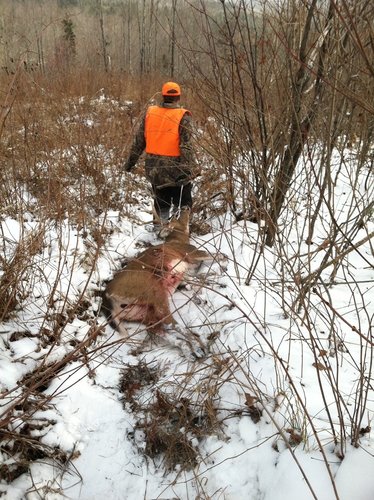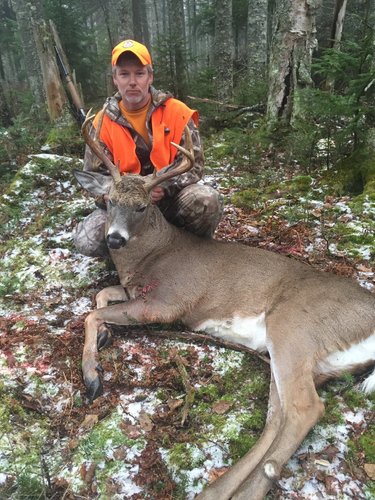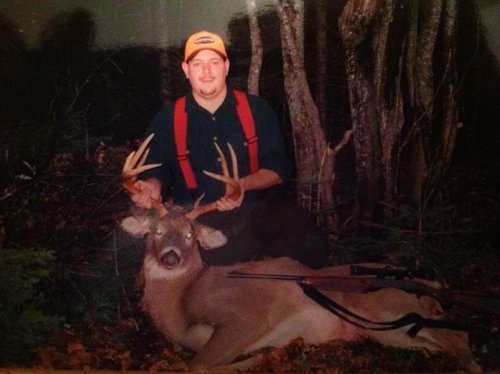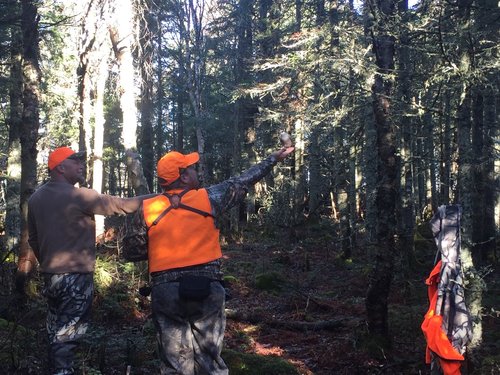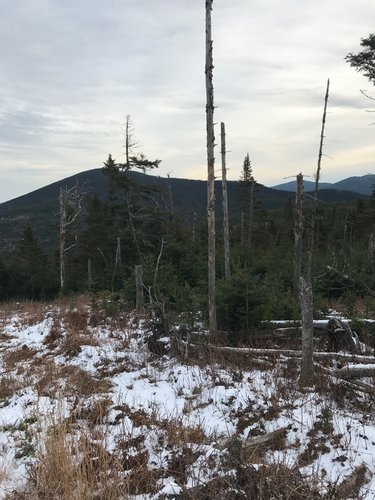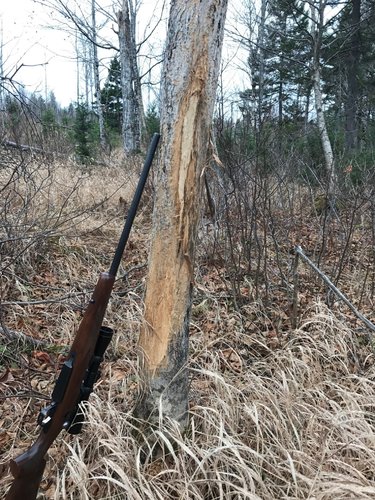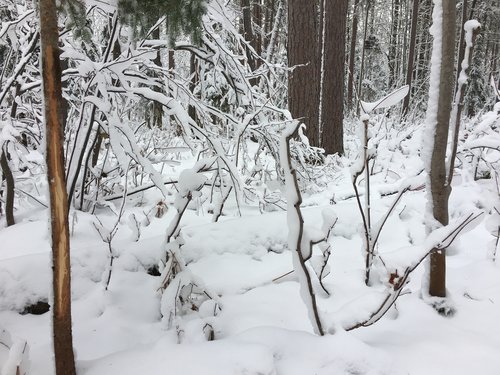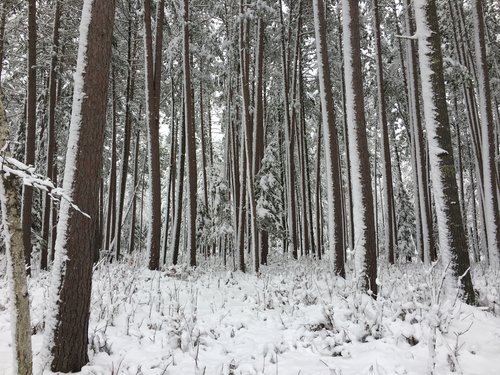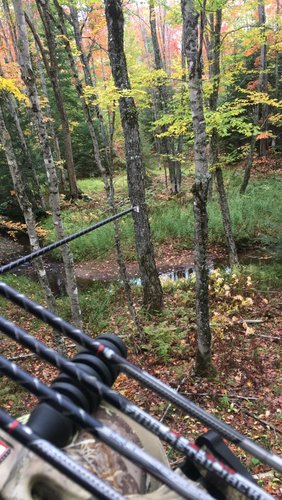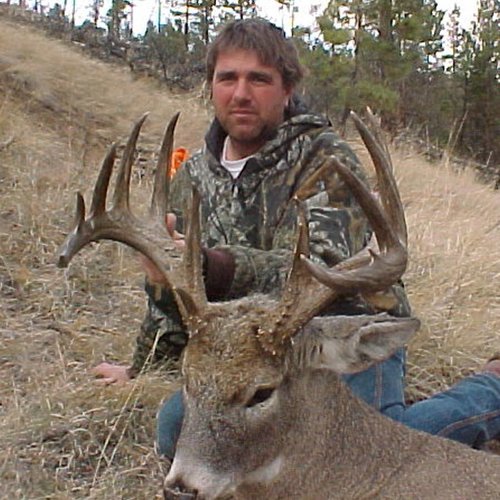Navigation
Install the app
How to install the app on iOS
Follow along with the video below to see how to install our site as a web app on your home screen.
Note: This feature may not be available in some browsers.
More options
You are using an out of date browser. It may not display this or other websites correctly.
You should upgrade or use an alternative browser.
You should upgrade or use an alternative browser.
Big woods whitetails
- Thread starter Nick87
- Start date
D
Deleted member 40728
Guest
I think I would rather go to Maine on a whitetail hunt any day over some mid western states. Just the challenge and hunt itself sounds fun
R
rwc101
Guest
I have called the PA wardens several times about idiotic things and seem to get brushed off a lot. I called once to express my displeasure with jacklighting deer and how I was tired of hearing gunshots at night and was informed that i needed to complain to my state representative as jacklighting is a recreational activity. Sorry, not trying to derail thread. Just thought it was interesting where some rules come from. Not always game commission.
My brother-in-law is a warden in Virginia. They have laws against shining a light at deer with or without a weapon, but it is still incredibly difficult to enforce. He spends a lot of nights laying in the brush with nothing to show for it.
huronmtns
Well-known member
3 to 8" of dry snow can be a big benefit hunting the big country whitetail. It makes walking much quieter and increases contrast to help pick out a deer. It also makes dragging a deer out much easier than on bare ground. My worst or longest drag was just over 1.5 miles on bare ground. It was low elevation and had 3 different streams to cross. 2 of the streams I utilized beaver dams as the country was very low flat and wet because the beavers had series of big ponds. One beaver damn was 200 plus yards long. Dragging a deer with decent antlers on a dam made out of thousands of sharp pointy beaver chewed wood spears sticking up is a real challenge and not very safe. Tripping because you are getting tired and impaling yourself on a beaver stick is a real concern. After that drag I decided hunting the higher ground was going to be more enjoyable. I have hunted the higher ground ever since. The snow comes earlier at the higher elevation. The snow changes the hunt tactics and sure makes it easier to drag a deer out. Level ground with snow is almost as easy as pulling a sled. Down hill grade dragging a deer is effortless. Steep downhill I have sat on the deer holding the antlers as handle bars and steered the deer while I was getting a ride. The country I hunt in is commercial forrest land and typically has some form of logging roads near or at the bottom of the hills. It makes dragging better than carrying meat most of the time.
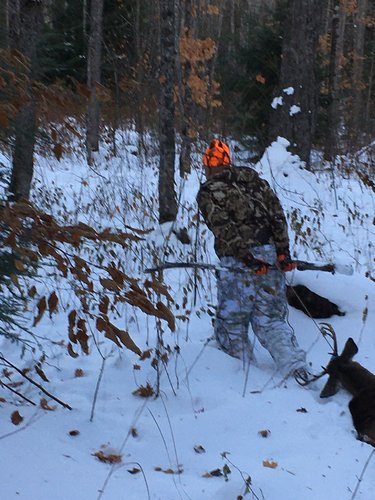

Last edited:
Dougfirtree
Well-known member
Yeah, well, they also can't hunt on Sundays...That seems like an old antiquated rule that could really stand to be updated. Anyone who has ever tried to drag a 200 pound deer any distance knows that it’s a chore. Makes you regret shooting it lol. I ran into a guy a few years ago at the truck that shot a buck about a half mile back on some public. He looked like he was about to kill over after dragging it all that distance in warm rainy weather. He admitted he wished he never shot it but I give him credit for working his ass off. I have found deer and elk before that have too much left behind because of people who don’t have a good plan for getting them out. It stinks that a regulation makes it that much more difficult for getting your animal out of the woods. Unless “in its entirety” means it can be broken down but all pieces must be accounted for when presented?
Dougfirtree
Well-known member
I do the same thing. Another great buck!For sure, and just like the no hunting on Sundays in Maine. Ridiculous. However, I'll never complain about dragging out a big old whitetail, no matter what shithole I shot him in. That's how I grew up and didn't know anything different until I hunted elk last fall. My worst drag was in 2016, when I shot a beauty buck on bare ground with rather warmer than usual weather. This guy had big shoulders, and dragged hard! It was the middle of the night when I finaly got out of the woods and to my truck, but it was cloudless and a full moon, so plenty of light. When I think back on it, there's no place I'd rather be, than dragging one out, as that's the easy part.
I carry my coat, rifle, and fanny pack about 100 yards, and then go back and drag the buck to my stuff. Gives your legs a little break when you do it this way.
Here he is
View attachment 132291
View attachment 132292
D
Deleted member 40728
Guest
I know guys that have used that style setup in PA to get big bears up and out of deep ravines so I think that would work good for deer as well.I hope I’m not derailing the op.
Before I realized it’s pretty much ok to take a deer out in a backpack in Il I was trying to think of ways to get a whole deer up a steep 50-100ft ravine alone.
Has anyone ever used a rope system like these climbers have to accomplish this task? Is there a better way?
View attachment 132293
Nick87
Well-known member
In Illinois it has to be whole until checked in also. It never occurred to me that our same "tele-check" may open new doors. I'll have to do some digging as long as I could get service this may allow someone to hunt a lot further in next time I go down to hunt the shawnee NF!It's illegal to quarter one in IN as well, at least until it's checked in. With the new-ish tele-check if I needed to, I would check it in by phone then proceed to quartering it.
Last edited:
targetpanic
Well-known member
One warning to all of the people on here saying they want to try hunting Northern New England...you can very easily cover 4-6 miles a day in the woods up here for 6 days straight and never see a deer. Many of the spots we hunt have deer densities of 1-3 dpsm...the problem is they can all be congregated into one square on the checkerboard and if you don't find that square, you wont find the deer.
We hunt in the mountains of NW Maine every season. It is the hardest hunting I do every year both physically and mentally...I wouldn't give it up for anything!!!
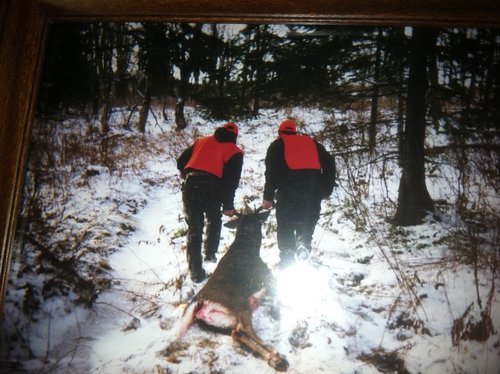
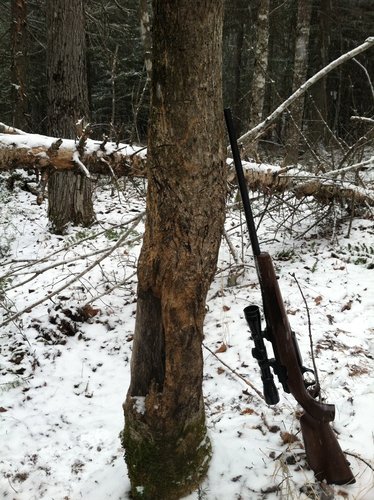
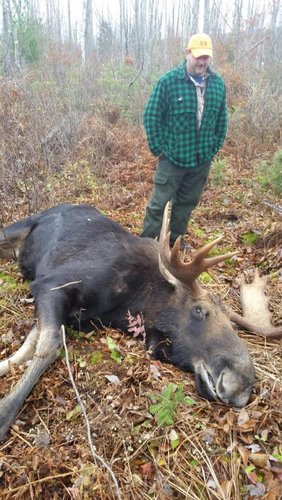
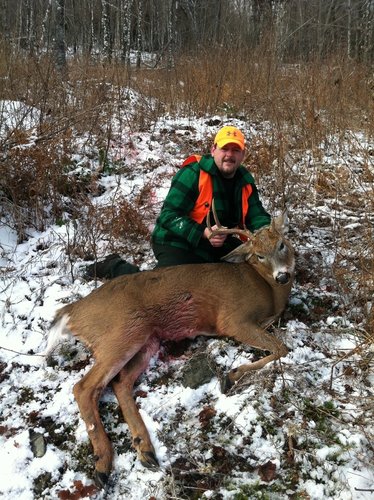
We hunt in the mountains of NW Maine every season. It is the hardest hunting I do every year both physically and mentally...I wouldn't give it up for anything!!!




targetpanic
Well-known member
Dougfirtree
Well-known member
Nice bucks and nice signpost! I've had the same experience in Maine, the deer get really concentrated and you have to find them, kind of like elk. Here in the Adirondacks, they tend to be a bit more evenly dispersed. I think the difference is all the logging and the higher lattitude in Maine. I think the big woods of the NE are one of the toughest hunts in North America.
antlerradar
Well-known member
Hilljackoutlaw
Well-known member
- Joined
- Jan 15, 2019
- Messages
- 7,174
Look at the mass on that dude!Most of the whitetails in Eastern Montana are riverbottom deer, but there are some whitetails that live in the pine forests. About as close to the big woods as you are going to get in eastern Montana.View attachment 133896
antlerradar
Well-known member
I am looking at the lack of gray hair on that dude holding the deer.Look at the mass on that dude!
Hunting the big woods for whitetail deer is what my hunting revolves around. I run 10 - 15 trail cams per year and hike hundreds of kilometers every year scouting/hunting. My "day job" is a high school teacher so my time afield is much more limited than I would like (e.g. weekends almost exclusively) and I scout a tonne to help me make that time as productive as possible. I hunt the big woods of Eastern Ontario and the Adirondacks of New York. In Eastern Ontario I live near thousands of acres of public land - unfortunately there are no access restrictions so it can be difficult to escape beyond the ATV crowd even though the entire area is unpopulated and 100% forested.
A few tips and tricks my from experience:
1) Think Big. Mature bucks in the big woods travel a lot during the rut and focusing on a small parcel of land is a mistake. For example, during our early December muzzleloader seaon in 2016 I cut a buck track in the snow at 8:30 AM while exploring a new area. I followed that buck 5 km as the crow flies to a location (ironically where I have spent a lot of time hunting) as he scent checked doe groups. I finally caught up to him at 2:30 PM in the afternoon as he dogged a group of does and fawns before missing a 75 meter offhand shot at a nice 8 point buck. Moral of the story - if the rut (or in this case the second rut) is on, mature bucks will be on their feet searching.
Moral of the story - if the rut (or in this case the second rut) is on, mature bucks will be on their feet searching.
2) Scout. I know this sounds blatantly obvious, but it ties directly into #1 Think Big. I spend a tonne of time searching Google Earth, topo maps, etc. and then hiking into those areas to see what is there. Sometimes an area that looks great on the map has an ATV trail or heavy hunter sign nearby - scratch it from the list. Scouting also helps when snow tracking or still hunting. If you know the general "lay of the land" you might be able to anticipate the buck's movement or perhaps terrain that might be more suitable to get a shot at him.
3) Deer Pockets. In the big woods deer tend to live in pockets. It's very common for me to walk hundreds of meters through the woods and see minimal deer sign. Then suddenly deer sign is everywhere in an area before I am back in a "dry area" again. Successful big woods hunting is about finding these population pockets and then figuring out how mature bucks are most likely to travel between them during the rut.
4) Mobility Rules. In the majority of my big woods hunting I am either still hunting or snow tracking. Deer densities are low and even sitting a good stand location may not yield a deer sighting for days. Without snow I look to move along the top of ridges (just below the lip so I'm not skylined), stopping frequently to rattle/sit for 20 minutes/etc. With snow it is an all out hike until I find the track I want (typically a track of 2.75 inches or wider is a mature buck around here) and then on the track. I push hard on the track - I'd rather risk spooking the buck and missing a chance than never catching up to him at all.
5) Be Prepared. I never step into the big woods to scout or hunt without some basic survival equipment. This depends on the season, but on late season solo hunts I carry enough gear to get me through an emergency overnight. Don't be statistic - being cold, wet, and lost could be the prelude to a tragedy without some basic survival skills and gear.
I'll share a few positive outcomes of my Ontario whitetail deer hunting. While there is plenty of Crown land in Eastern/ Central Ontario, it typically sees high hunter pressure during the two week rifle season in early November. This is "big woods" country - beaver ponds, conifer swamps, thick hardwoods. In most places you can't see further than 75 to 100 meters.
In 2017 I had identified a small drainage as a likely buck travel corridor during the rut through prior scouting. I had trail cams set up in the vicinity and had captured several bucks using the drainage as a travel corridor in the early days of the rut (including as it turned out the buck I eventually shot).
November 10 was a bitterly cold morning, -10 C and windy. I had still hunted back into the drainage and was slowly working my way into the wind. The drainage was about 75 meters wide - tangled conifer growth. On the south side a ridge rose quickly into a old logging clear cut. At 8:45 AM I had dropped down into the drainage itself (the stream is literally a meter wide) when I suddenly heard leaves rustling and twigs breaking. I quickly looked up to my left (south) on the side of the ridge to see flashes of a big grey body and large antlers flashing through the brush. What happened next was "auto pilot". As the buck entered a shooting lane at 30 meters my rifle was on its way to my shoulder and I was grunting to stop the buck. He came to an immediate stop and looked down in my direction just as I touched off my 308 BLR. He took off at lightning speed, turning down into the drainage and tearing past me at literally 10 meters. I fired as he passed me and then got a rapid third after him as he disappeared north across the drainage at full speed.
My hunting partner joined me and we found blood at the initial shot site. Soon the blood trail was very apparent and we found him piled up about 100 meters away. Turns out I had hit him lethally with 2 of the 3 shots fired.
It was a classic Eastern "big woods" hunt. Hours/days of minimal action and then mere seconds of wild "up close and personal" action. Here in Eastern Ontario the peak chasing phase of the rut always seems to hit November 8 - 10. Those three days can be absolute magic with the big boys on their feet and moving hard.
He dressed out at 195 lbs and scored around 135 inches gross - he's on the wall in my "man cave" now as my best buck to date.

In 2018 we were fortunate to get a decent snowfall late in the first week of the season in early November. From the time I stepped out of my truck before sunrise, I knew it was a “deer hunting” day - cold temperatures, raw wind, and leaden skies. I cut my first buck track just after legal light and after an hour of tracking him and several other deer he had followed, I came upon this buck standing at the bottom of a logging cut below me. A single offhand shot from 135 meters with my BLR 308 brought the hunt to an end. I can’t be entirely sure this was the exact buck I was tracking - but I had many trail camera photos of this particular buck from my summer and fall scouting. He had a typical 8 point rack and the butcher estimated him at around 175 lbs.

In 2019 I wasn't able to get on a mature buck during the two week rifle season so took to the field for our early December muzzeloader season. I hiked back into an area that sees almost zero hunting pressure. I was simply looking to fill the freezer and had an antlerless tag so could shoot any deer I saw. After several hours on the track of a group of deer, I was able to make a 40 meter shot on a mature doe. It was a tough 2.5 km solo drag back to the truck, but another awesome big woods adventure.
A few tips and tricks my from experience:
1) Think Big. Mature bucks in the big woods travel a lot during the rut and focusing on a small parcel of land is a mistake. For example, during our early December muzzleloader seaon in 2016 I cut a buck track in the snow at 8:30 AM while exploring a new area. I followed that buck 5 km as the crow flies to a location (ironically where I have spent a lot of time hunting) as he scent checked doe groups. I finally caught up to him at 2:30 PM in the afternoon as he dogged a group of does and fawns before missing a 75 meter offhand shot at a nice 8 point buck.
2) Scout. I know this sounds blatantly obvious, but it ties directly into #1 Think Big. I spend a tonne of time searching Google Earth, topo maps, etc. and then hiking into those areas to see what is there. Sometimes an area that looks great on the map has an ATV trail or heavy hunter sign nearby - scratch it from the list. Scouting also helps when snow tracking or still hunting. If you know the general "lay of the land" you might be able to anticipate the buck's movement or perhaps terrain that might be more suitable to get a shot at him.
3) Deer Pockets. In the big woods deer tend to live in pockets. It's very common for me to walk hundreds of meters through the woods and see minimal deer sign. Then suddenly deer sign is everywhere in an area before I am back in a "dry area" again. Successful big woods hunting is about finding these population pockets and then figuring out how mature bucks are most likely to travel between them during the rut.
4) Mobility Rules. In the majority of my big woods hunting I am either still hunting or snow tracking. Deer densities are low and even sitting a good stand location may not yield a deer sighting for days. Without snow I look to move along the top of ridges (just below the lip so I'm not skylined), stopping frequently to rattle/sit for 20 minutes/etc. With snow it is an all out hike until I find the track I want (typically a track of 2.75 inches or wider is a mature buck around here) and then on the track. I push hard on the track - I'd rather risk spooking the buck and missing a chance than never catching up to him at all.
5) Be Prepared. I never step into the big woods to scout or hunt without some basic survival equipment. This depends on the season, but on late season solo hunts I carry enough gear to get me through an emergency overnight. Don't be statistic - being cold, wet, and lost could be the prelude to a tragedy without some basic survival skills and gear.
I'll share a few positive outcomes of my Ontario whitetail deer hunting. While there is plenty of Crown land in Eastern/ Central Ontario, it typically sees high hunter pressure during the two week rifle season in early November. This is "big woods" country - beaver ponds, conifer swamps, thick hardwoods. In most places you can't see further than 75 to 100 meters.
In 2017 I had identified a small drainage as a likely buck travel corridor during the rut through prior scouting. I had trail cams set up in the vicinity and had captured several bucks using the drainage as a travel corridor in the early days of the rut (including as it turned out the buck I eventually shot).
November 10 was a bitterly cold morning, -10 C and windy. I had still hunted back into the drainage and was slowly working my way into the wind. The drainage was about 75 meters wide - tangled conifer growth. On the south side a ridge rose quickly into a old logging clear cut. At 8:45 AM I had dropped down into the drainage itself (the stream is literally a meter wide) when I suddenly heard leaves rustling and twigs breaking. I quickly looked up to my left (south) on the side of the ridge to see flashes of a big grey body and large antlers flashing through the brush. What happened next was "auto pilot". As the buck entered a shooting lane at 30 meters my rifle was on its way to my shoulder and I was grunting to stop the buck. He came to an immediate stop and looked down in my direction just as I touched off my 308 BLR. He took off at lightning speed, turning down into the drainage and tearing past me at literally 10 meters. I fired as he passed me and then got a rapid third after him as he disappeared north across the drainage at full speed.
My hunting partner joined me and we found blood at the initial shot site. Soon the blood trail was very apparent and we found him piled up about 100 meters away. Turns out I had hit him lethally with 2 of the 3 shots fired.
It was a classic Eastern "big woods" hunt. Hours/days of minimal action and then mere seconds of wild "up close and personal" action. Here in Eastern Ontario the peak chasing phase of the rut always seems to hit November 8 - 10. Those three days can be absolute magic with the big boys on their feet and moving hard.
He dressed out at 195 lbs and scored around 135 inches gross - he's on the wall in my "man cave" now as my best buck to date.

In 2018 we were fortunate to get a decent snowfall late in the first week of the season in early November. From the time I stepped out of my truck before sunrise, I knew it was a “deer hunting” day - cold temperatures, raw wind, and leaden skies. I cut my first buck track just after legal light and after an hour of tracking him and several other deer he had followed, I came upon this buck standing at the bottom of a logging cut below me. A single offhand shot from 135 meters with my BLR 308 brought the hunt to an end. I can’t be entirely sure this was the exact buck I was tracking - but I had many trail camera photos of this particular buck from my summer and fall scouting. He had a typical 8 point rack and the butcher estimated him at around 175 lbs.

In 2019 I wasn't able to get on a mature buck during the two week rifle season so took to the field for our early December muzzeloader season. I hiked back into an area that sees almost zero hunting pressure. I was simply looking to fill the freezer and had an antlerless tag so could shoot any deer I saw. After several hours on the track of a group of deer, I was able to make a 40 meter shot on a mature doe. It was a tough 2.5 km solo drag back to the truck, but another awesome big woods adventure.
Last edited:
tzone
Well-known member
I love hunting big woods whitetails. I’m bad at it so I don’t have much advice to offer. Most of my success has been hunting ridges. In my experience ridges are about the only place big woods bucks will move during the day as they are very nocturnal. Most ridges offer some decent shooting lanes and rutting bucks seem to like ridges. Here are some crappy pictures of some pretty heavy deer. The archery buck was only 2.5 years old but I was pretty pumped to get an early season big woods buck with my bow. I was sitting behind a tree.
Awesome pics!!
Grew up hunting northern NH where seeing a deer or 2 for the 4 weekends we could hunt made it "good". But when you get one, its probably big.
Tracking in the snow is really fun, but you have to keep good track of where you are, them deers tend to go UP away from roads, you can easily find yourself 5+ miles in and it getting dark.
Fun when it comes together though.,
Tracking in the snow is really fun, but you have to keep good track of where you are, them deers tend to go UP away from roads, you can easily find yourself 5+ miles in and it getting dark.
Fun when it comes together though.,
ShortAction
Active member
Agreed. On my bucket list!I think I would rather go to Maine on a whitetail hunt any day over some mid western states. Just the challenge and hunt itself sounds fun




